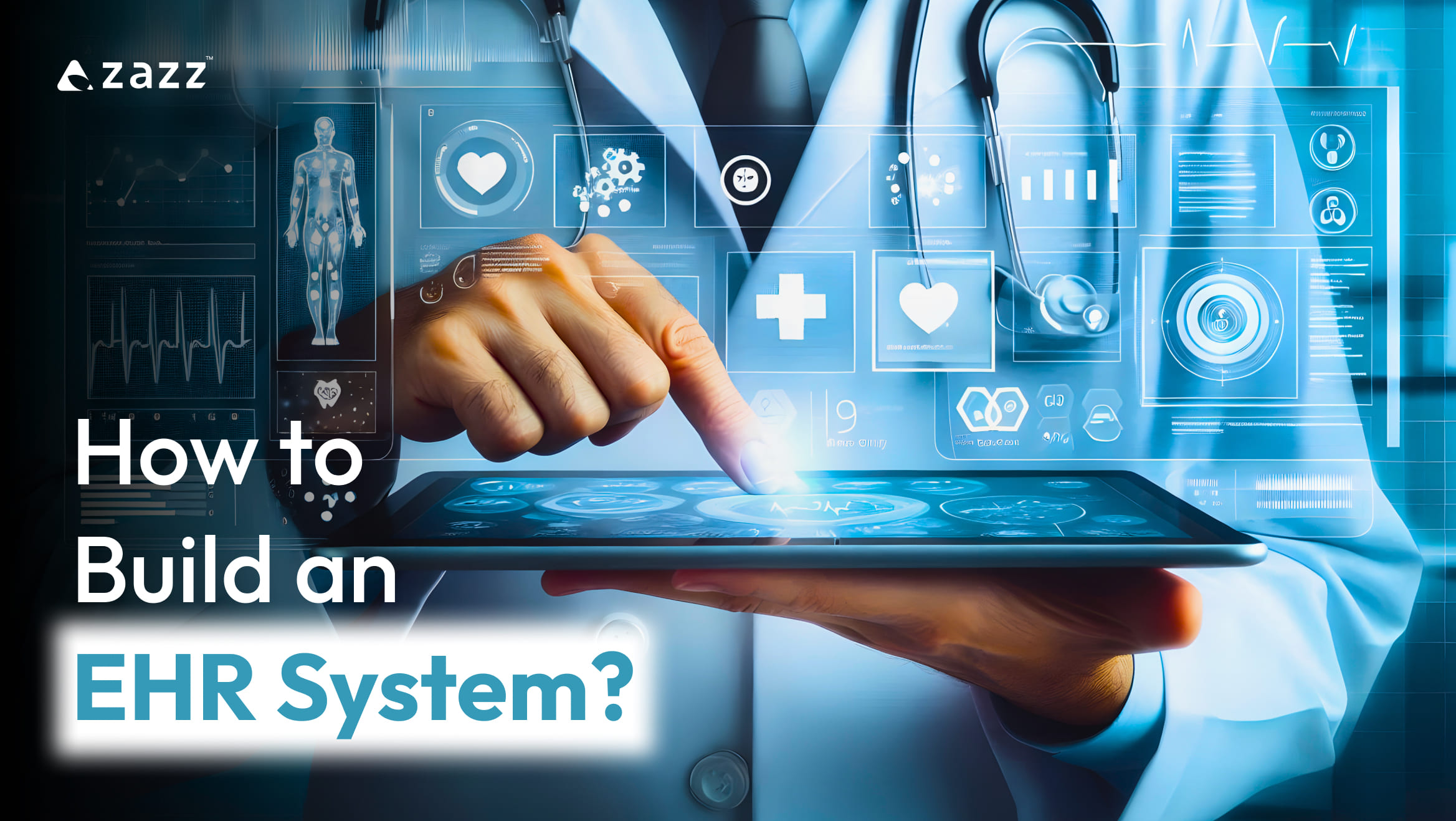
In the rapidly evolving landscape of healthcare technology, Electronic Health Records (EHR) systems have become essential for managing patient information. These digital records improve the efficiency, accuracy, and accessibility of health data, ultimately enhancing patient care. In this post, we’ll explore what an EHR system is, its key components, and a step-by-step guide on how to build one.
What is EHR?
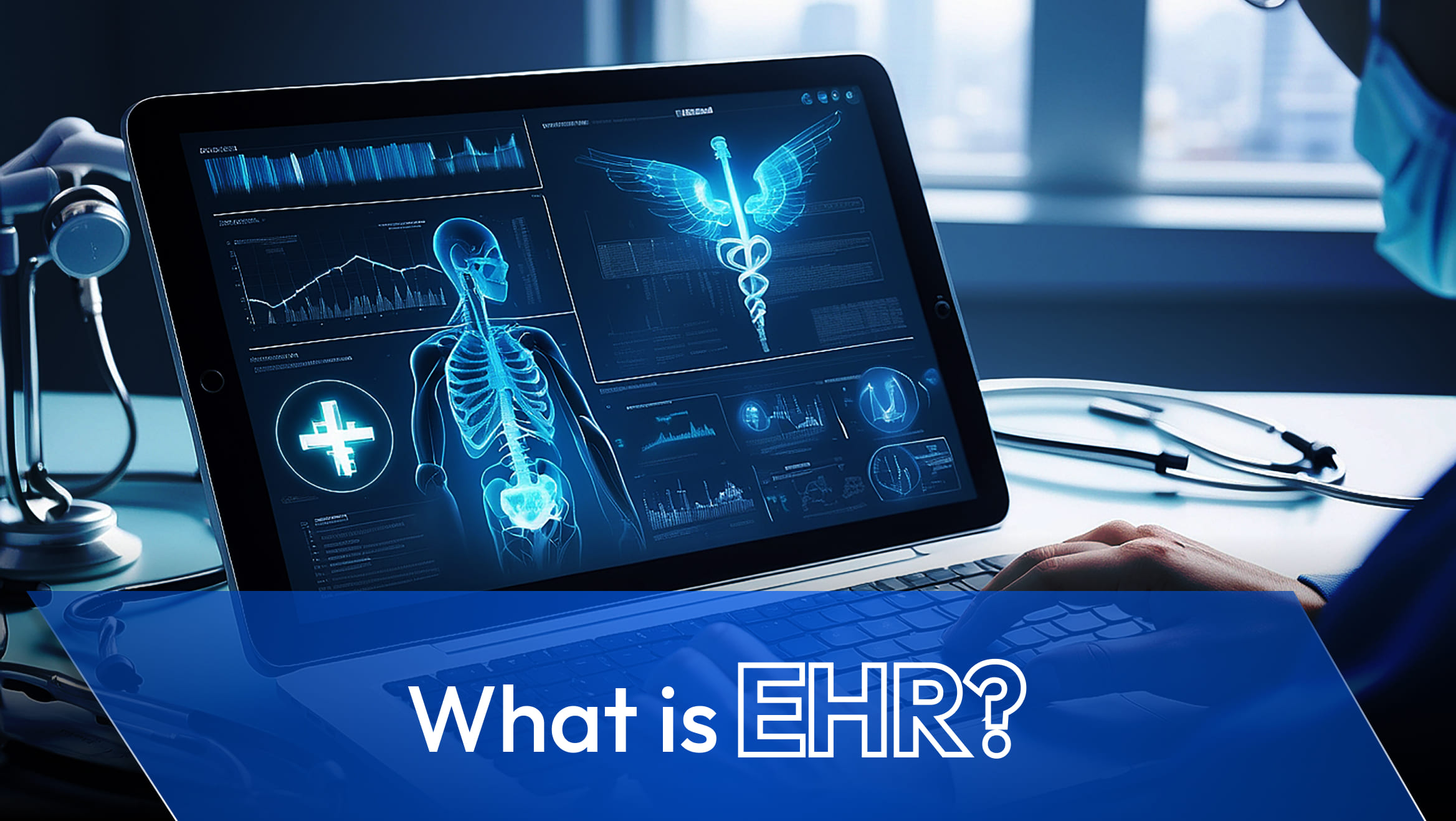
Electronic Health Records (EHR) are comprehensive digital records of patient health information that are designed to be effortlessly & seamlessly shared across various healthcare devices. Unlike traditional paper records, EHRs provide real-time access to patient data, enabling healthcare providers to make informed decisions quickly and efficiently. EHRs typically include a wide range of information, such as:
- Patient Demographics: Basic information like name, age, gender, and contact details.
- Medical History: A chronological account of the patient’s medical history, including past diagnoses, surgeries, and hospitalizations.
- Medication Records: Details on current and past medications, including dosages and administration routes.
- Allergies if any: Information on any known allergies to medications or substances.
- Test reports: Results from diagnostic tests, such as blood tests and radiology images, with direct integration from lab systems.
- Clinical Notes: Documentation from healthcare providers during patient encounters, capturing assessments, treatment plans, and follow-ups.
Building an EHR system enhances the quality of patient care by ensuring that all relevant patient information is readily available to authorized healthcare professionals, thereby supporting better clinical decisions and improved patient outcomes. Find the overall benefits of building an EHR system below, followed by a guide on how to build it, the cost involved & the expertise required so that you can have the much-needed clarity when you decide to build one.
Related reading: Building Custom Medical Billing Software: A Complete Guide
Benefits of EHR Systems
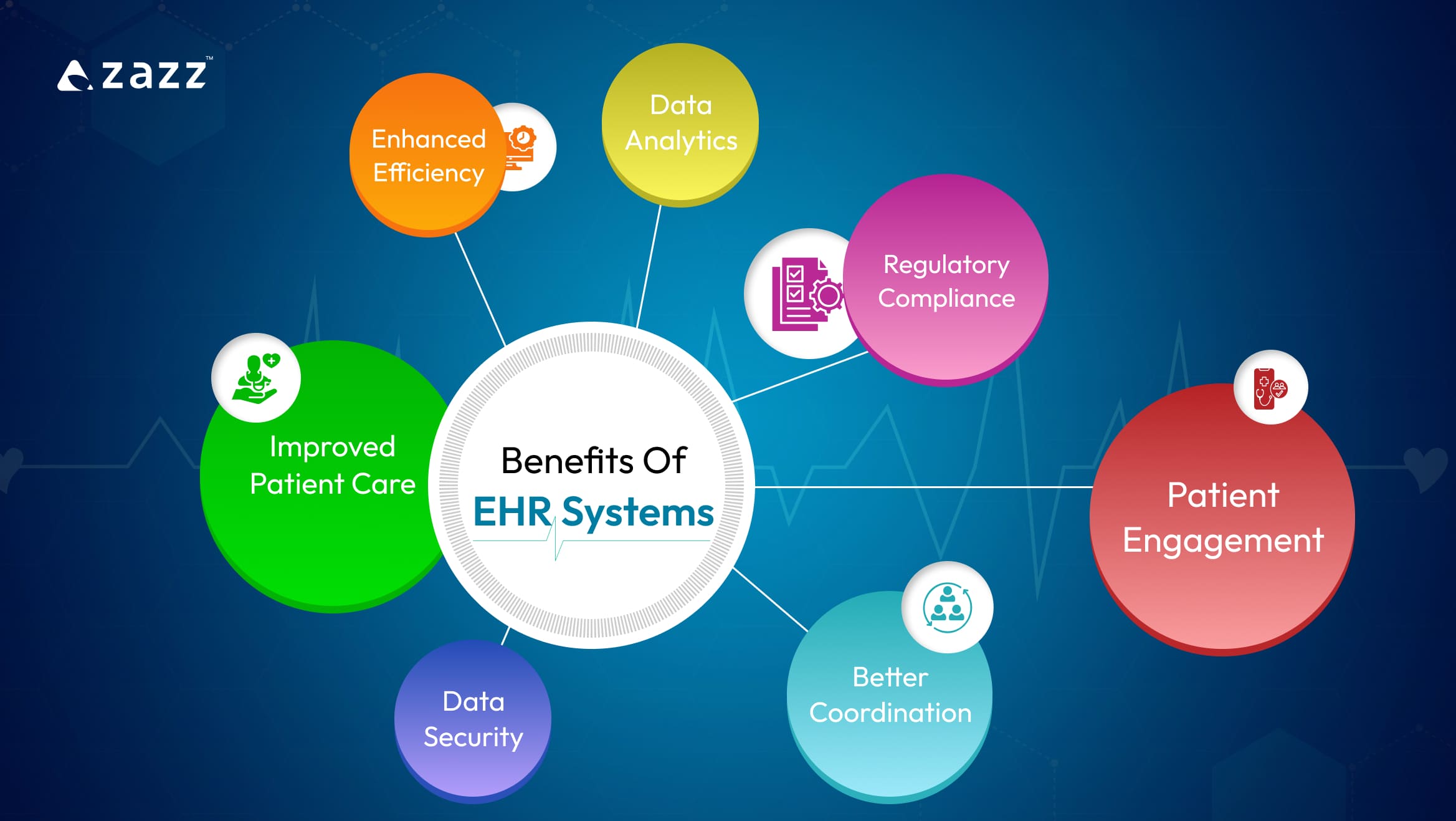
Implementing EHR systems offers numerous benefits to healthcare providers, patients, and the healthcare ecosystem as a whole:
- Improved Patient Care: EHRs provide instant access to comprehensive patient information, enabling healthcare providers to make informed clinical decisions and improve patient outcomes.
- Enhanced Efficiency: Streamlined workflows reduce administrative burdens, allowing healthcare providers to focus more on patient care rather than paperwork.
- Better Coordination: Interoperability enables seamless communication among healthcare providers, improving collaboration and continuity of care for patients.
- Data Security: EHRs implement robust security measures to protect sensitive patient data from unauthorized access and breaches, ensuring compliance with regulations.
- Regulatory Compliance: EHRs assist healthcare organizations in adhering to healthcare regulations, reducing the risk of non-compliance penalties.
- Data Analytics: The ability to analyze patient data supports decision-making, quality improvement initiatives & aids in patient population management.
- Patient Engagement: EHRs often include patient portals that empower patients to access their health information, communicate with providers, and manage appointments, fostering greater engagement in their own healthcare.
If you are into healthcare business and looking forward to getting started with EHR system development, you are at the right place. Zazz is a reliable and resourceful EHR app development company that has been the go-to IT partner for many healthcare organizations in USA. Start your EHR software development journey with expert guidance
Before you know how to build an EHR system, it is essential to be informed of the basic features that it should have.
What are the Must-Have Features of Fully Developed EHR Systems?
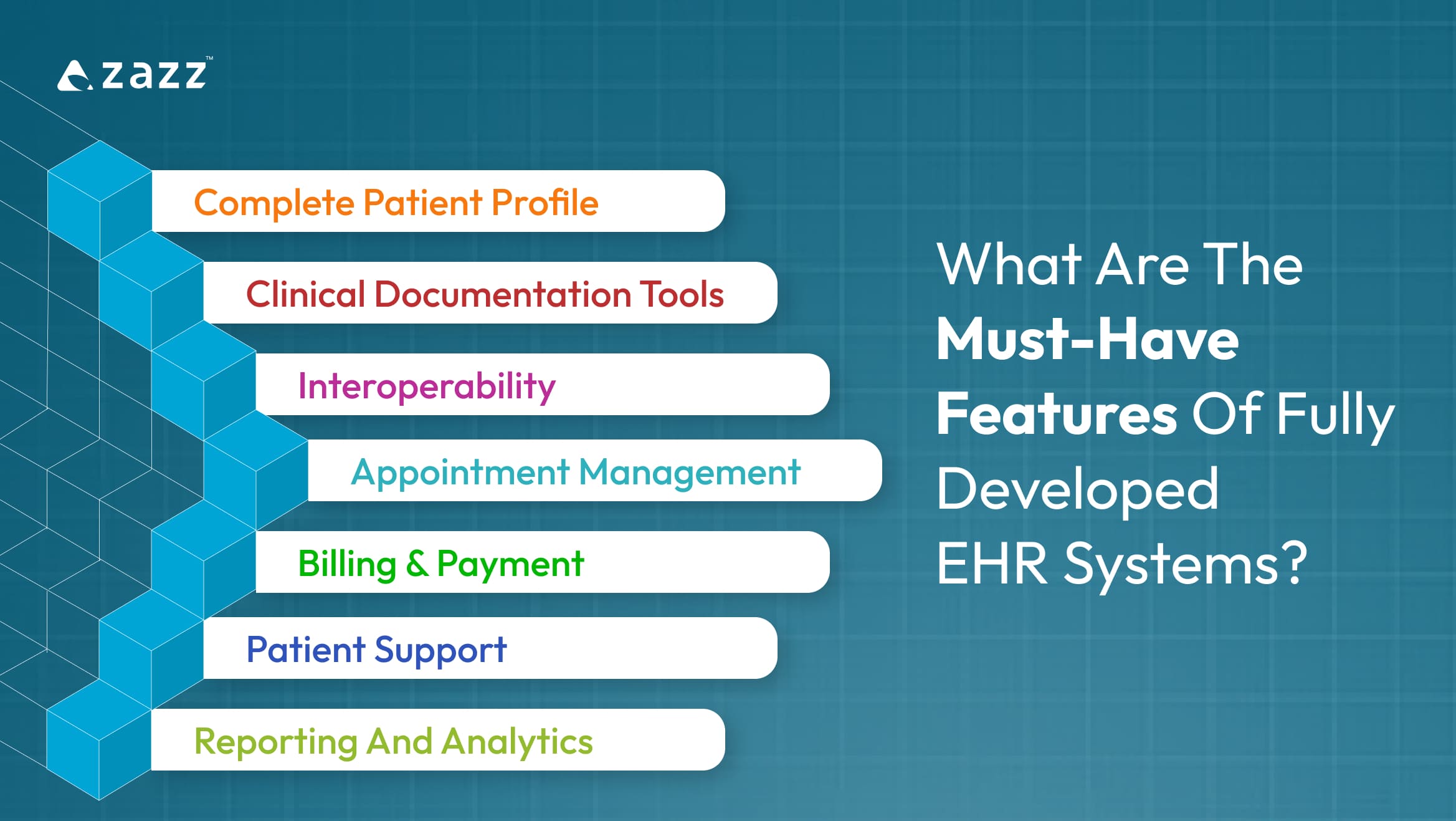
A fully developed EHR system should include the following must-have features to ensure it meets the diverse needs of patients, healthcare providers and organizations:
- Complete Patient Profile: To identify and manage patient records and this will include patients’ personal information, – their name, age, place, and other aspects of their biography like occupation, marital status and other distinguishing factors that helps with personalized patient care.
- Clinical Documentation Tools: To allow healthcare providers to digitally document their clinical notes,that include patient visits, progress records, follow-up plans etc.,
- Interoperability: To share EHRs from one healthcare device to another seamlessly, helping with easy access of records in laboratories, pharmacies, and other hospitals, to promote coordinated care.
- Appointment Management: To schedule, reschedule and cancel appointments, as well as send automated reminders about the appointment status to patients and practitioners.
- Billing & Payment: To generate invoice, keep track of the payment status , insurance claim management & for insurance claim management.
- Patient Support: To assist patients on any query related to medication, allergies, and preventive care based on clinical guidelines.
- Reporting and Analytics: To generate a consolidated report on clinical outcomes, operational efficiency, and compliance metrics to support quality improvement initiatives.
- Data Security and Compliance: To protect sensitive health information by implementing robust security protocols, including data encryption, access controls, and audit trails with regulations like HIPAA.
- Communication Portal: To communicate with providers, request prescription refills, and manage appointments.
- Cross-platform functionality: For the interface to function seamlessly across all devices be it android, or ios or web.
In addition to the above mentioned features, there are more nuances that will act as a key differentiator in your EHR software. To build such a nuanced EHR system, an expert guidance is the best option. Get in touch with the experienced app developers at Zazz|
The electronic healthcare system development doesn’t confine to one type. There are different types of EHR systems, categorized pertaining to their usability and they can also be customized based on the ask.
Related reading: Developing a Healthcare App in 2024 – A Complete Guide
Types of EHR Systems
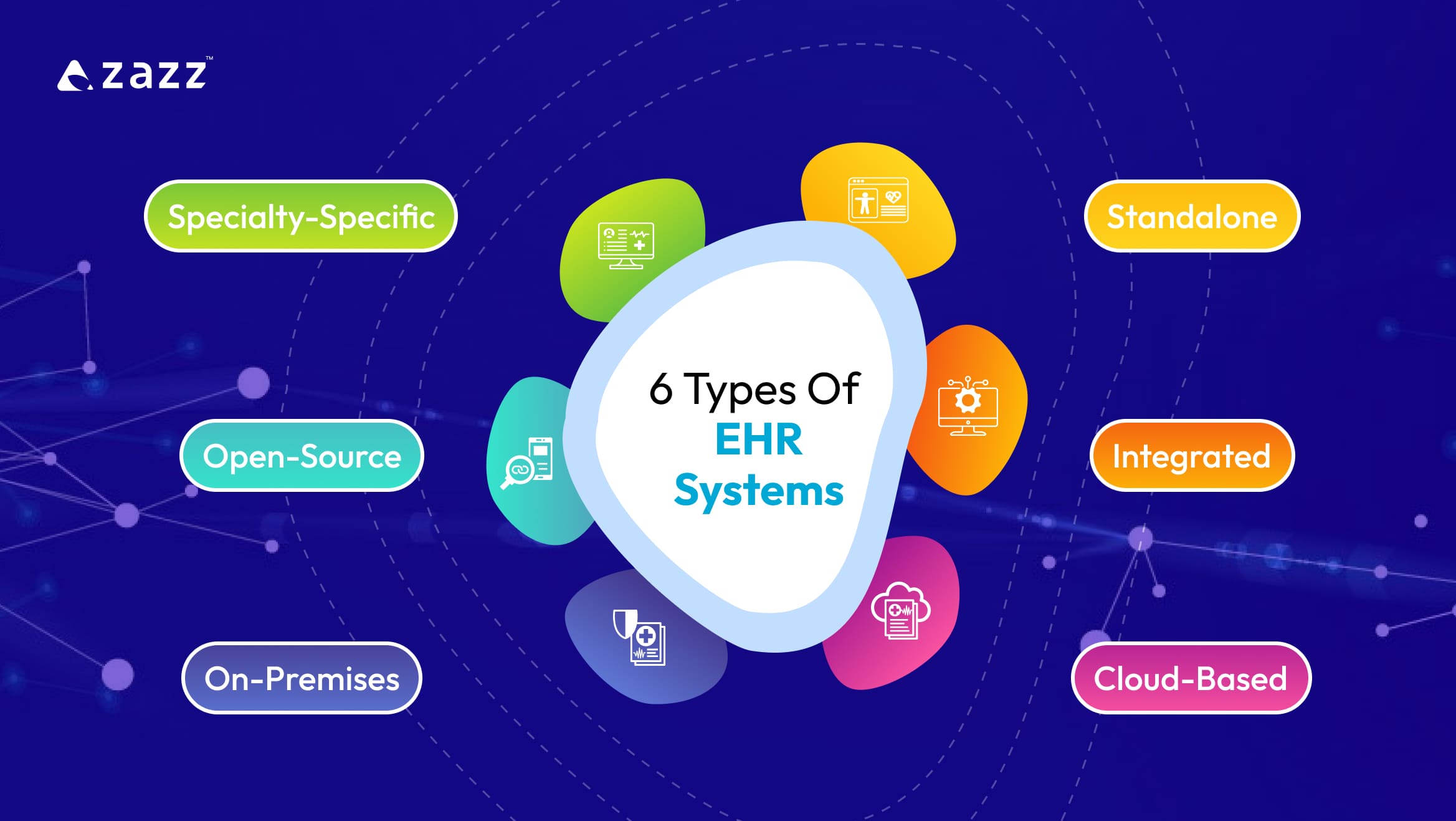
EHR systems can be categorized based on deployment models, functionality, and target users. The main types include:
- Standalone EHR Systems: These systems operate independently and are often developed for small scale practise. Hence, they may lack integration with other healthcare systems as the functionality is confined to a particular healthcare organization or group of practitioners.
- Integrated EHR Systems: These EHRs are integrated with other essential healthcare applications like pill reminder, patient management, wellness app etc., improving accessibility and care coordination.
- Cloud-Based EHR Systems: Hosted on cloud servers, these systems offer flexibility, scalability, allowing better resource management and accessibility of patient records. They typically reduce the need for on-site infrastructure and maintenance.
- On-Premises EHR Systems: Installed locally on a healthcare organization’s servers. These systems offer healthcare organizations a high degree of control, customization, and security over their patient data.
- Open-Source EHR Systems: These are existing Electronic Health record software, with readily-available infrastructure for organizations, patients and healthcare professionals to adapt to it as per their needs.
- Specialty-Specific EHRs: Designed for specific medical specialties (e.g., pediatrics, dermatology). These EHRs come equipped with features that are unique to the clinical requirements of a speciality.
When evaluating EHR systems, organizations must consider not only the initial investment but also ongoing costs and the specific needs of their practice. Customization, user training, and support are critical factors that influence overall expenses. Understanding these cost dynamics can help healthcare organizations make informed decisions about their EHR investments.
| Type of EHR System | Initial Costs (Approx.) | Ongoing Costs (Annual) |
| Standalone EHR | $20,000 – $95,000 | $50,000 – $100,000 |
| Integrated EHR | $30,000 – $150,000 | $60,000 – $120,000 |
| Cloud-Based EHR | $1,000 – $5,000 (setup) + $2,400 – $8,400 (subscription) | $1,000 – $2,000 |
| On-Premises EHR | $40,000 – $250,000 | $70,000 – $120,000 |
| Open-Source EHR | $5,000 – $50,000 | $5,000 – $15,000 |
| Specialty-Specific EHR | $20,000 – $150,000 | $60,000 – $100,000 |
Related reading: How Custom Software Development is Changing the Healthcare Industry
Tech Stack for Building an Electronic Health Record system development
Building a robust EHR system requires a carefully selected technology stack. The key components typically include:
- Frontend Technologies: Frameworks such as React, Angular, or Vue.js for creating an intuitive and responsive user interface that ensures ease of navigation for healthcare providers.
- Backend Technologies: Server-side frameworks like Node.js, Django that handle business logic, manage database interactions, and provide GraphQL or RESTful APIs for frontend integration.
- Database Management: Relational databases (e.g., PostgreSQL, MySQL) for structured data storage, or NoSQL databases (e.g., MongoDB) for flexibility in handling unstructured data.
- API Development: Creating RESTful or GraphQL APIs that facilitate communication between the frontend and backend development, as well as integration with external systems such as laboratories and pharmacies.
- Cloud Infrastructure: Leveraging cloud platforms like AWS, Google Cloud, or Microsoft Azure for hosting the application, ensuring scalability, reliability, and data security.
- Security Frameworks: Implementing security measures such as OAuth2 for authentication, SSL/TLS for data encryption, and secure coding practices to protect sensitive health information.
If you are looking forward to hiring an IT team to build your EHR system, below is a list of professionals you would require and what to look for in them. But, the best way is to opt for IT staff augmentation instead of full-time hiring. Zazz has the IT talents essential for EHR development, which means you don’t have to look further. Check out staff augmentation services at Zazz|
Team Required for Electronic Health Record Development
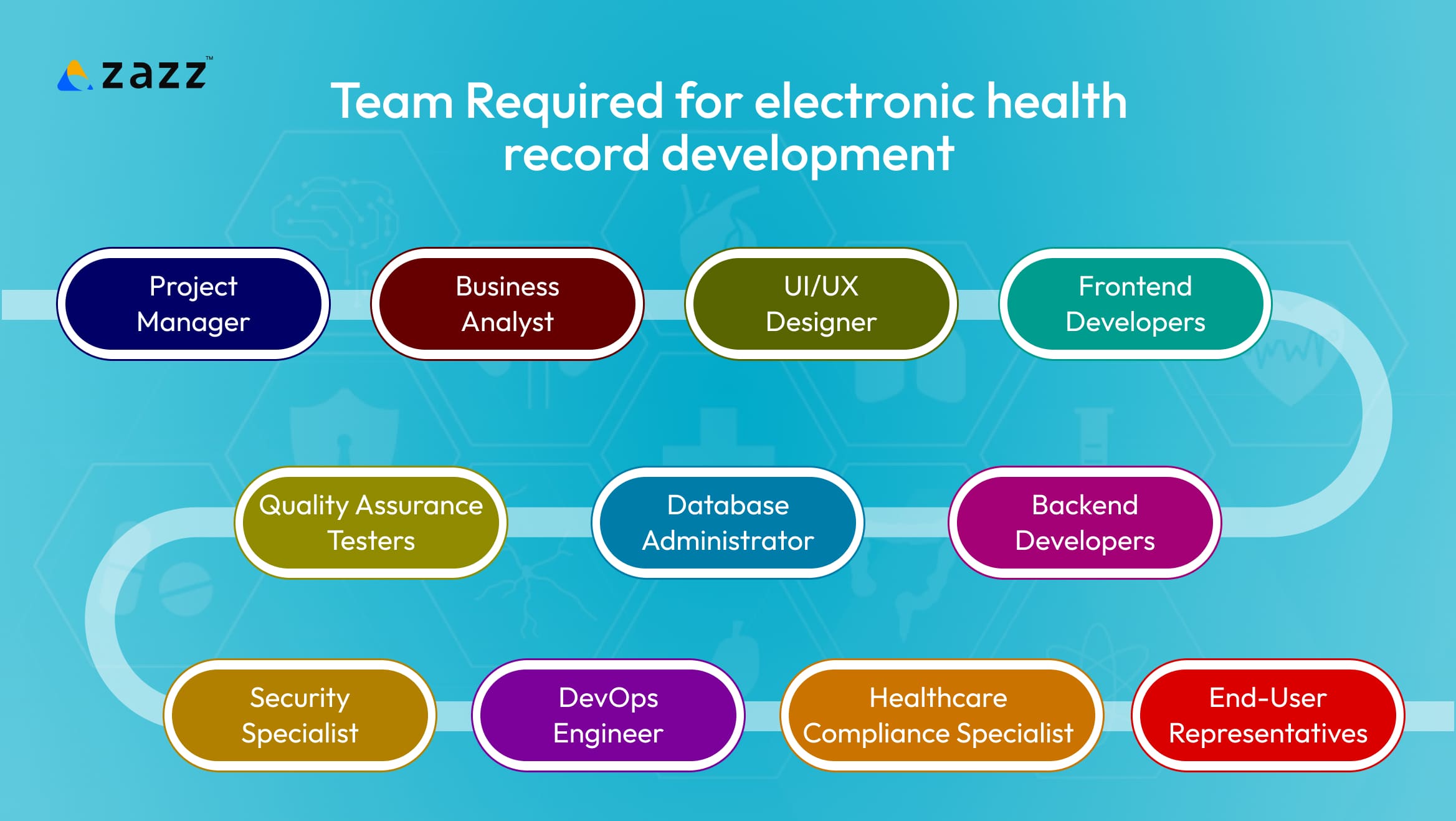
The successful development of an EHR system hinges on the collaboration of a diverse team with specialized skills. By assembling a well-rounded team, organizations can enhance the likelihood of a successful EHR implementation that improves patient care and operational efficiency.
1. Project Manager
- Responsibilities: Oversee the project from inception to completion, ensuring it stays on schedule and within budget. Facilitate communication among team members and stakeholders.
- Skills Needed: Strong leadership, excellent communication, project management methodologies (e.g., Agile, Scrum), and familiarity with healthcare regulations.
2. Business Analyst
- Responsibilities: Gather requirements from stakeholders, analyze existing workflows, and translate user needs into technical specifications. Ensure that the software aligns with regulatory requirements and industry standards.
- Skills Needed: Analytical thinking, problem-solving, understanding of healthcare processes, and strong communication skills.
3. UI/UX Designer
- Responsibilities: Design the UI and UX, focusing on usability and accessibility. Create wireframes, prototypes, and visual designs that cater to healthcare providers’ needs.
- Skills Needed: Proficiency in design tools (e.g., Sketch, Figma, Adobe XD), understanding of user-centered design principles, and knowledge of accessibility standards.
4. Frontend Developers
- Responsibilities: Build the user interface components using frontend technologies. Ensure that the application is responsive, functional, and provides a seamless user experience.
- Skills Needed: Proficiency in HTML, CSS, JavaScript, and frameworks such as React, Angular, or Vue.js.
5. Backend Developers
- Responsibilities: Develop the server-side logic, manage database interactions, and implement APIs that connect the frontend and backend. Ensure data security and performance optimization.
- Skills Needed: Expertise in server-side programming languages (e.g., Node.js, Python, Ruby), knowledge of database management systems (e.g., SQL, NoSQL), and familiarity with API development.
Related reading: Software Architecture for Healthcare Apps in 2024
6. Database Administrator (DBA)
- Responsibilities: Design and manage the database structure, ensuring data integrity, security, and efficient data retrieval. Implement backup and recovery plans.
- Skills Needed: Proficiency in database technologies (e.g., PostgreSQL, MySQL, MongoDB), strong analytical skills, and experience with database optimization.
7. Quality Assurance (QA) Testers
- Responsibilities: Conduct testing to identify bugs and usability issues. Ensure the software meets functional requirements and adheres to Quality Assurance.
- Skills Needed: Knowledge of testing methodologies (manual and automated), familiarity with testing tools (e.g., Selenium, JUnit), and strong attention to detail.
8. Security Specialist
- Responsibilities: Ensure that the EHR system complies with healthcare regulations (e.g., HIPAA) and implements robust security measures to protect sensitive patient data.
- Skills Needed: Expertise in cybersecurity principles, knowledge of data encryption and access control methods, and familiarity with compliance standards.
9. DevOps Engineer
- Responsibilities: Facilitate collaboration between development and operations teams, streamline the deployment process, and ensure system reliability and scalability.
- Skills Needed: Experience with cloud platforms (e.g., AWS, Azure), automation tools (e.g., Jenkins, Docker), and configuration management.
10. Healthcare Compliance Specialist
- Responsibilities: Ensure the EHR system complies with relevant healthcare laws, regulations, and industry standards. Conduct audits and risk assessments.
- Skills Needed: In-depth knowledge of healthcare regulations (e.g., HIPAA, HITECH), strong analytical skills, and experience with compliance audits.
11. End-User Representatives
- Responsibilities: Serve as representatives of the end users (e.g., physicians, nurses, administrative staff) to provide insights on workflows, usability, and feature requirements.
- Skills Needed: Understanding of clinical workflows, effective communication skills, and the ability to gather and provide feedback from various user perspectives.
Now that the roles and responsibilities involved in building a EHR system is clearly defined, here is how the process goes:
Steps to Build an EHR System
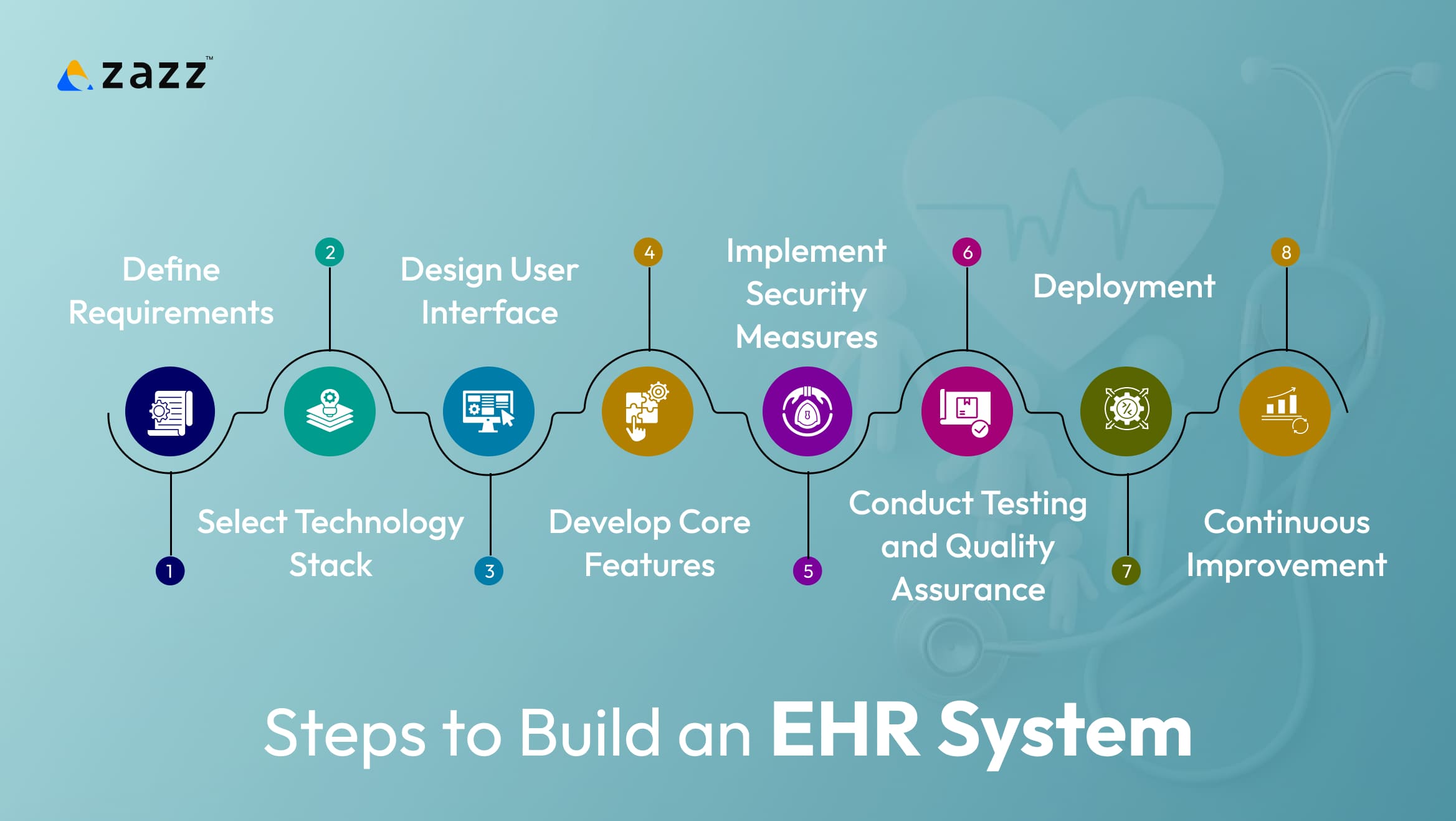
Building an EHR system involves several critical steps: Here is an overview
- Define Requirements: Engage stakeholders—including healthcare providers, administrators, and IT staff—to gather detailed requirements and understand the specific needs of the organization.
- Select Technology Stack: Choose the appropriate technologies for the frontend development, backend development, database, and cloud infrastructure, ensuring they align with the project’s goals.
- Design User Interface: Create wireframes and prototypes that prioritize user experience, focusing on intuitive navigation and accessibility for all users.
- Develop Core Features: Features such as patient management, clinical documentation, billing integration, and reporting tools that form the foundation of an EHR system.
- Implement Security Measures: Integrate security protocols, including data encryption, access controls, and audit trails, to protect sensitive health information.
- Conduct Testing and Quality Assurance: Perform thorough testing to identify and rectify bugs and usability issues. Engage end-users in testing to gather feedback and ensure the system meets their needs.
- Deployment: Launch the EHR system, providing comprehensive training for healthcare providers and staff to facilitate a smooth transition and encourage adoption.
- Continuous Improvement: Monitor the system’s performance, gather user feedback, and implement regular updates to enhance functionality and security while adapting to changing healthcare needs.
Related reading: How can AI help reduce readmissions?
Building an Electronic Health Record (EHR) system is a complex yet rewarding endeavor that holds the potential to transform healthcare delivery. As we’ve explored, the process involves careful planning, collaboration, and a multidisciplinary approach to ensure that the system meets the unique needs of healthcare providers and patients alike. From understanding the essential features and selecting the right technology stack to assembling a skilled team and adhering to compliance regulations, each step is critical to the project’s success.
As healthcare continues to evolve, investing in a robust EHR solution is not just an option; it’s a necessity for organizations aiming to stay competitive and provide the highest quality of care.
Ultimately, the journey of building an EHR system is an ongoing one, requiring continuous improvement and adaptation to changing technologies and regulatory landscapes. By prioritizing user engagement, maintaining a focus on security, and fostering a culture of innovation, healthcare organizations can successfully navigate the challenges and reap the long-term benefits of an effective EHR system.
Build a best in class EHR system with Zazz- Your reliable EHR development partner
Frequently Asked Questions
An Electronic Health Record (EHR) system is a digital version of a patient’s paper chart that contains comprehensive health information, including medical history, diagnoses, medications, lab results, and treatment plans. EHRs are designed to be shared across different healthcare settings, improving coordination and continuity of care.
EHR systems streamline workflows, reduce paperwork, and enhance patient care by providing real-time access to patient data. They facilitate better communication among healthcare providers, enable more accurate diagnosis thereby improving patient safety.
Yes, reputable EHR systems are designed with strong security measures including data encryption, access controls, and audit trails to protect sensitive patient information . They are also built to comply with healthcare regulations, such as HIPAA, which sets standards for the privacy and security of health information.
EHR systems can be categorized into several types, including stand-alone systems, integrated systems, cloud-based solutions, on-premises solutions, open-source systems, and specialty-specific EHRs. Each type is based on the needs of the healthcare organization and has its own benefits.
Organizations should consider factors such as cost, ease of use, interoperability with other systems, customization options, scalability, vendor support, and compliance with regulatory requirements. It’s essential to involve end-users in the selection process to ensure the chosen system meets their needs.
Successful implementation requires a comprehensive need-assessment, clear project management, user training, and ongoing support. Engaging stakeholders early in the process, providing thorough training for users, and establishing robust IT support are key to overcoming challenges and ensuring a smooth transition to the new system.
Recent Articles
Table of Content 1. Data Engineer vs. Data Scientist: Understanding...
Table of Content 1. What is the Carnival in Brazil?...
Table of Content 1. What is IT Staff Augmentation? 2....












